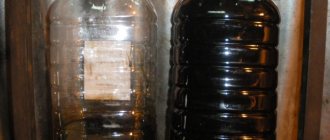How many grams are in 1 liter of milk?
The density of milk can change depending on temperature and pressure. Question: How many grams are in 1 liter of milk? Answer: 1 gram of milk = 0.000971 liters, 1 liter of milk = 1030 grams.
Interesting materials:
How to distribute the Internet over a local network via Wi Fi? How to distribute Internet from iPad to iPhone? How to distribute Wi-Fi from a tablet? How to divide a number by 10? How to separate a mixture of alcohol and water? How to split a page into two PDF parts? How to smooth out Eco-leather on a stroller? How to smooth a genuine leather skirt? How to smooth a leather sheepskin coat? How to iron a leather jacket?
Features of converting gasoline of different brands from liters to tons
How much does the body of a VAZ 2106 weigh? How much does a VAZ car (Lada, Lada, Niva) weigh? engine and transmission
To correctly carry out the calculation, you need to know the density values of the required brand of petroleum product based on the table. It is best, of course, to take a fuel sample and measure the density of the fuel at a set temperature according to current standards.
On average, the density of fuel at 20 ºС is 0.75 g/l. Using the directory data and performing a simple calculation, we find that the volume of one ton of gasoline ranges from 1282 to 1429 liters.
To perform more accurate calculations, it is necessary to correct for temperature, because The density according to the standard in the reference books is indicated taking into account the temperature from plus 15 to plus 20 ºС. If the temperature is outside this range, a temperature correction must be taken into account.
Hydrocarbon Density
| Fuel | Density at 20 ºС, g/cm3 |
| Oil | from 0.74 to 0.97 |
| Jet fuel | from 0.76 to 0.84 |
| Automotive fuel | from 0.71 to 0.76 |
| Engine oil | from 0.88 to 0.94 |
| Aviation fuel | from 0.73 to 0.75 |
| Diesel fuel | from 0.80 to 0.85 |
| Fuel oil | from 0.92 to 0.99 |
To accurately calculate the hydrocarbon density using these data at a given temperature, you will need average temperature correction data:
| Density at 20oC | Correction for temperature by 1oC | Density at 20oC | Correction for temperature by 1oC |
| from 0.650 to 0.659 | 0,962 * 10-3 | from 0.830 to 0.839 | 0,725 * 10-3 |
| from 0.660 to 0.669 | 0,949 * 10-3 | from 0.840 to 0.849 | 0,712 * 10-3 |
| from 0.670 to 0.679 | 0,936 * 10-3 | from 0.850 to 0.859 | 0,699 * 10-3 |
| from 0.680 to 0.689 | 0,925 * 10-3 | from 0.860 to 0.869 | 0,686 * 10-3 |
| from 0.690 to 0.699 | 0,910 * 10-3 | from 0.870 to 0.879 | 0,673 * 10-3 |
| from 0.700 to 0.709 | 0,897 * 10-3 | from 0.880 to 0.889 | 0,660 * 10-3 |
| from 0.710 to 0.719 | 0,884 * 10-3 | from 0.890 to 0.899 | 0,647 * 10-3 |
| from 0.720 to 0.729 | 0,870 * 10-3 | from 0.900 to 0.909 | 0,633 * 10-3 |
| from 0.730 to 0.739 | 0,857 * 10-3 | from 0.910 to 0.919 | 0,620 * 10-3 |
| from 0.740 to 0.749 | 0,844 * 10-3 | from 0.920 to 0.929 | 0,607 * 10-3 |
| from 0.750 to 0.759 | 0,831 * 10-3 | from 0.930 to 0.939 | 0,594 * 10-3 |
| from 0.760 to 0.769 | 0,818 * 10-3 | from 0.940 to 0.949 | 0,581 * 10-3 |
| from 0.770 to 0.779 | 0,805 * 10-3 | from 0.950 to 0.959 | 0,567 * 10-3 |
| from 0.780 to 0.789 | 0,792 * 10-3 | from 0.960 to 0.969 | 0,554 * 10-3 |
| from 0.790 to 0.799 | 0,778 * 10-3 | from 0.970 to 0.979 | 0,541 * 10-3 |
| from 0.800 to 0.809 | 0,765 * 10-3 | from 0.980 to 0.989 | 0,528 * 10-3 |
| from 0.810 to 0.819 | 0,752 * 10-3 | from 0.990 to 1.000 | 0,515 * 10-3 |
| from 0.820 to 0.829 | 0,738 * 10-3 |
How to count:
- From the gasoline passport we take the density of the fuel at a temperature of plus 20 oC.
- Determine the average temperature of the fuel in the gas tank.
- We calculate the difference between plus 20 oC and the average fuel temperature.
- Using the temperature correction column, we find a correction of 1oC, which corresponds to the density of the selected fuel at plus 20oC.
- We multiply the temperature correction by the temperature difference.
- We subtract the number obtained in point 5 from the density value at plus 20 oC, if the average temperature of the fuel in the gas tank is higher than plus 20 oC. Or we add this number if the fuel temperature is below plus 20 oC.
For example, the density of gasoline at plus 20 oC from the gasoline passport is 0.801 g/cm3. The temperature of the fuel in the gas tank is plus 25 oC. From the table we take the density of the fuel at a given temperature. We get:
- Temperature difference: 25 oC – 20 oC = 5 oC.
- The temperature correction per 1 oC from the table for a density of 0.801 g/cm3 is equal to 0.765 * 10-3 g/cm3.
- We calculate the correction for temperature by 5 oC: 0.765 * 10-3 * 5 = 0.003825 g/cm3, or approximately 0.0038 g/cm3.
- We determine the required fuel density at a temperature of plus 25 oC (we subtract the correction, since the temperature of the fuel in the gas tank is higher than plus 20 oC): 0.801 - 0.0038 = 0.7972 g/cm3.
The question of how to correctly convert liters of gasoline into tons turned out to be not too difficult.
Table of the influence of temperature on the density of kerosene, kg/m3
Temperature corrections were used to calculate volume changes for different grades of kerosene at different temperatures.
| -20°C | -10°C | 0°C | 10°C | 30°C | 40°C | 50°C | |
| TS1 | 811 | 803,76 | 795,84 | 787,92 | 772,08 | 764,16 | 756,24 |
| RT | 810,2 | 802,15 | 794,1 | 786,05 | 769,95 | 761,9 | 753,85 |
| T1 | 849,08 | 841,56 | 834,04 | 826,52 | 811,48 | 803,96 | 796,44 |
| T2 | 788,24 | 779,93 | 771,62 | 763,31 | 746,69 | 738,38 | 730,07 |
| T6 | 869,48 | 862,36 | 855,24 | 848,12 | 833,88 | 826,76 | 819,64 |
| Lighting | 868,48 | 861,36 | 854,24 | 847,12 | 832,88 | 825,76 | 818,64 |
| KO30 | 821,12 | 813,34 | 805,56 | 797,78 | 782,22 | 774,44 | 766,66 |
| KO22 and 25 | 835,6 | 827,95 | 820,3 | 812,65 | 797,35 | 789,7 | 782,05 |
| KO20 | 859 | 851,75 | 844,5 | 837,25 | 822,75 | 815,5 | 808,25 |
Heat always causes expansion. This means that the same substance will take up more space. Reference values are given based on a correction factor.
If you need to calculate more accurately, you can use the correction factors below. They show how much the volume of 1 cube changes when the temperature changes by 1 degree Celsius.
- TC1 – 0.792
- RT – 0.805
- T1 – 0.752
- T2 – 0.831
- T6 – 0.712
- Lighting – 0.712
- KO30 – 0.778
- KO22 and 25 – 0.765
- KO20 – 0.725
It is important to remember that if the temperature drops, then we add the value multiplied by the number of temperature drops; if it rises, then we subtract the multiplied value. Why is that? When a substance cools, it contracts; when it expands, it increases in volume.
Suppose a cube of T6 kerosene at +30 degrees weighs 833 kg. How much will the cube weigh at 0°C?
Falling to 0°C it will lose 30°C, which means you need to multiply 30 by a coefficient and add it to 833. Remember, a coefficient is a number that changes the volume of a cube when its temperature changes by 1 degree.
How exactly?
The temperature drops: Weight of the cube + (Temperature * coefficient) = 833 + (30 * 0.712) = 854 kg of T6 kerosene in the cube, at a temperature of 0 degrees.
If the temperature rises from +30 to another 30, then you will need to subtract. Because the substance will expand and take up more space, which means less kerosene will fit into the cube.
There may be confusion due to unfamiliarity with calculating these values, but after reviewing the calculations several times, there will be more clarity.
Barrel of kerosene
- A barrel is 158 liters. It is known that the average weight of kerosene is 0.8 kg per liter.
- This means: 158 liters of kerosene weigh on average 126 kg (158 * 0.8).
- Which is 0.126 of 1 ton.
- There are 7.9 barrels of kerosene in a ton.
Following the example of these calculations, you can calculate for a specific brand of kerosene, based on the data in the tables above.
Transition formula
It is known that body weight is found by arithmetic multiplying the volume of a petroleum product, measured in liters, and its density. Mass is understood as a physical quantity that characterizes the performance of a body: its inert and spatial properties in space.
Oil and diesel fuel in this case are determined using special density reference tables. For the final calculation of the mass of combustible fuel in tons, you can use a formula known from a school physics course.
m = V × ρ, where:
- m is the mass of the product, measured in kilograms;
- V is the volume of gasoline. Measured in cubic meters;
- ρ is the density of the substance. We determine it using special tables.
For calculations we use the generally accepted SI system. It is a worldwide system for measuring physical quantities. Also, do not forget to make the necessary conversions into units of measurement:
- liters will need to be converted to cubic meters using the formula: 1 liter is 0.001 cubic meters. meters;
- convert tons to kilograms, use the formula: 1 ton = 1000 kg.
Read also:
What does the octane number of gasoline depend on?
View this post on Instagram
Publication from REGIONTRANS (@regiontr.ru) January 10, 2022 at 12:53 PST
Interesting facts about gasoline
- Gasoline, unlike water, expands steadily with increasing temperature. Temperature correction – 1 ml per 1 liter with an increase (decrease) in temperature by 1 degree. Accordingly, by filling with colder fuel, you can remove more gasoline from the gas station.
- Gasoline ranks first in the international trade turnover ranking. Humanity uses more gasoline than tea and coffee, which share second place.
- Americans buy $1 billion worth of gasoline per day.
- Venezuela has the cheapest gasoline, only about 5 cents per liter, and the most expensive in Norway and Turkey (data from Bloomberg).
- During Gadaffi's rule in Libya, water was more expensive than gasoline, and fuel cost 14 cents.
- In the 19th century, gasoline was used as an antiseptic.
- A “distant relative” of gasoline, benzoic acid was known to alchemists during the time of Nostradamus. It was extracted from a then popular incense called “benzoy”.
- As a result of direct distillation of oil, only no more than 25% of the original volume of gasoline was previously obtained. More modern processing methods make it possible to obtain up to 80% of high-quality fuel from the original volume of oil.
What does the current fuel density depend on?
The current density of diesel fuel depends on its brand and temperature. You can find out its density at a temperature of 15 or 20 degrees Celsius in the quality certificate.
The higher the temperature of the oil product, the less 1 liter will weigh, and the volume of a kilogram of fuel will increase.
When converting units of measurement, the formulas are used: m = p * V and V = m / p.
To check whether the density of diesel fuel corresponds to the data specified in the quality passport, you need to take a liter of diesel fuel, weigh it and place it in the temperature environment in which the manufacturer conducted density tests: +150C or +200C. The exact weight of the fuel must be divided by its volume. We get the current density and compare it with the passport data.
AI 95 technical specifications
What is 1 liter in kg?
how much does a liter of water weigh in kilograms: numbers and facts The refueling gasoline Ron 95. Man's hand holding the filling gun. AI 95 gasoline is intended for use in foreign-made passenger cars. It has an octane number of at least 85 according to the motor research method, and not lower than 95 according to the research method. The density of the product at a temperature of 15°C is 725-780 kg/m3. The induction period is at least 360 minutes. Manganese content is not specified. The lead content, regulated by GOST, is no more than 0.010 g/dm3. However, for gasolines produced on the Russian market and meeting the EURO 4 standard, the permissible content of lead and manganese is virtually reduced to zero. Mass fraction of sulfur is not more than 0.05%. Resin content is no more than 5 mg/100 cm3. The volume fraction of benzene is not more than 5%. According to the results of a test on a copper plate, which determines the corrosiveness of gasoline, it corresponds to class 1. Upon visual observation, the appearance of gasoline is clean and transparent. This brand of fuel has improved performance characteristics. For its production, aromatic components, gas gasoline and other high-tech components are used. The peculiarity of AI 95 gasoline “Extra” is the complete absence of lead.
It should be noted that the technical characteristics of gasoline largely depend on the technological capabilities of the petroleum product manufacturer. At the same time, state standards guarantee compliance with the minimum standards provided for a particular brand of gasoline.
How does the density of a substance affect the calculation of its mass in tons?
The number of cubic meters of petroleum product depends on the ratio of mass to volume. The value, in turn, depends on the quality and manufacturer. A high value of the indicator indicates high-quality raw materials. We have already figured out above that the volume of fuel in liters increases during heating; at sub-zero temperatures, the fuel turns into a jelly-like substance and becomes thick. When recalculating, it will be necessary to take into account the influence of temperature, as well as other influencing factors. To perform specific calculations, you will need to use professional tables containing the required indicators, taking into account the effect of temperature on the fuel.
State standards applicable to gasoline
Until the end of the nineties, the production of petroleum products in Russia, in particular the production of gasoline, was regulated by GOST 2084 and TU 38.001165. These standards regulated the production of gasoline grades from A 76 to AI 96 based on their octane number. At that time, the global fuel industry was rapidly developing, cars had powerful engines, and issues of ecology and environmental protection were just beginning to be raised by individual countries. Accordingly, little attention was paid to environmental fuel standards.
Later, outdated GOSTs, along with technological progress, were replaced by newer quality standards that meet modern environmental requirements. Thus, in 1999, GOST R 51105-97 was introduced, regulating the compliance of gasoline with the requirements of the EURO 2 standard. However, in Europe at this time the issue of environmental protection became increasingly relevant. Already in 2000, a more modern environmental quality standard, EURO 3, was introduced in Europe, significantly reducing the permissible levels of metal compounds, including heavy metals, in gasoline.
Following European environmental standards, in Russia, on July 1, 2002, a new standard GOST R 51866-2002 (EH 228-2004) was adopted. This standard has already applied to the brands of high-quality high-octane gasoline Premium Euro 95 and Super Euro 98, as well as their types.
A few years later in the European Union, the EURO 3 standard was replaced by the new environmental standard EURO 4. Following this, in Russia, on January 1, 2015, GOST 32513-2013 and TU 0251-001-12150839-2015 were adopted. Both of these documents set quality standards for modern gasoline, with an octane number of at least 80 according to the research method.
After the introduction of the new EURO 5 standard, environmental requirements for fuel quality have become significantly stricter. In Russia, the EURO 5 standard has been adopted since January 1, 2022. In fact, currently all imported cars imported into Russia and the fuel produced comply with this standard. Today, technical regulations regulate more than twenty characteristics of gasoline, including the proportion of benzene, which increases the octane number of gasoline, but causes significant harm to the environment. In addition, in accordance with EURO 5 requirements, gasoline is not allowed to contain metal-containing components that form toxic compounds and seriously affect the environment.
What is the density of diesel fuel?
Density characterizes the mass of a substance that fits into one cubic meter. The higher the density, the greater this indicator. Enterprises that produce diesel fuel closely monitor this value. If it does not meet state standards, the fuel does not receive a passport and is not allowed for sale.
Density indicates the amount of energy released during fuel combustion. The denser it is, the more energy is obtained and the higher the efficiency of the unit.
However, the increased density of the product indicates the presence of heavy compounds in its composition, which subsequently impair engine performance. As a result of using such fuel, carbon deposits form on the walls of the internal combustion engine chambers.
In accordance with the standards, the following density values are established:
- for summer diesel fuel – 860 kg/m3;
- for winter – 840 kg/m3;
- for the Arctic – 830,860 kg/m3.










